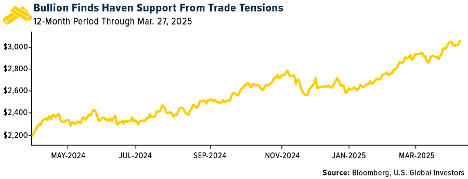Strengths
- The best-performing precious metal for the past week was silver, up 3.91%. on the back of gold’s lift this week as precious metals got a boost from rising trade tensions, helping to send gold to another all-time high along with a new upgrade in year-end forecasted price gains by Goldman.

- Gold-backed exchange-traded funds continued to see big inflows, adding the most in more than three years on Monday. ETFs added 23 tons of gold in the trading session closed on Monday, the biggest one-day increase since 2022, according to data collected by Bloomberg.
- Gold has solidified its position as a safe-haven asset, rising 17% year-to-date to over $3,100 per ounce, driven by geopolitical uncertainty, inflation concerns and strong central bank demand. This surge has further boosted gold miners and funds that invest in gold miners, which have outperformed the S&P 500 year-to-date.
Weaknesses
- The worst performing precious metal for the past week was platinum, down 0.25%. Platinum continues to face headwinds from other precious metals, such as gold and silver, which have had record years this year.
- Royalty valuations remain higher than the miners’, likely due to their insulation from the inflationary cost environment. The group is trading at 2.11x P/NAV, representing a 1.33x premium to operators (higher than the historical average of 0.50x), compared to a 1.77x P/NAV and a 1.01x premium to operators, according to Scotia.
- According to Bank of America, Harmony Gold Mining is a high-cost gold producer with a fourth quartile cost position. They have falling production and higher all-in sustaining costs (AISCs). Production is down in FY25 on lower production at Hidden Valley and Doornkop. They indicate the company’s track record on fatalities at its mining operations in the past is troubling. Despite the negative outlook. Harmony was a top 10 performer this week, gaining nearly 10%.
Opportunities
- Gold Fields has announced a non-binding indicative and conditional proposal to acquire 100% of Gold Road Resources. It has been rejected by the Gold Road Board. The proposal was for cash consideration of A$3.05 per share, comprising a fixed portion of A$2.27 plus a variable portion equal to the value of each shareholder’s proportion of GOR's shareholding in De Grey Mining (DEG), according to Canaccord.
- According to Bank of America, China's insurance industry can invest 1% of its assets in gold, equivalent to around 6% of the annual gold market. Central banks currently hold about 10% of their reserves in gold and could raise this figure to +30% to make their portfolios more efficient. Finally, retail investors have also been increasing their exposure to the yellow metal, with assets under management at physically backed ETFs increasing by nearly 6% year-to-date in the Americas, Europe and Asia.
- Goldman Sachs ramped up its gold price forecast to $3,300 an ounce by year-end, citing stronger-than-expected central bank demand and solid inflows into bullion-backed exchange-traded funds. The bank’s increasingly bullish view on the precious metal was evident in the new forecast from analysts Lina Thomas and Daan Struyven, who had just last month upgraded their end-2025 price target to $3,100 an ounce, according to Bloomberg.
Threats
- A senior White House official has hinted at the possibility of the U.S. utilizing its gold reserves to acquire more Bitcoin. Bo Hines, the executive director of the President’s Council of Advisers on Digital Assets, suggested in an interview that the U.S. could capitalize on the gains from its gold holdings to purchase more Bitcoin. This move, according to Hines, could be a budget-neutral way to increase the country’s Bitcoin reserves, according to Benzinga Newswire.
- For 2025, miner production guidance is expected to be 4% lower and cost guidance 4%-5% higher than 2024. Although costs are expected to remain relatively high, Scotia believes the current higher gold price environment, coupled with some relief on input cost pressures and FX, should position companies for further margin improvement.
- The narrowing U.S. trade deficit (driven by strong exports and reduced imports) could temporarily strengthen the dollar, pressuring gold prices as a stronger dollar typically weighs on dollar-denominated commodities, Bloomberg reports.

